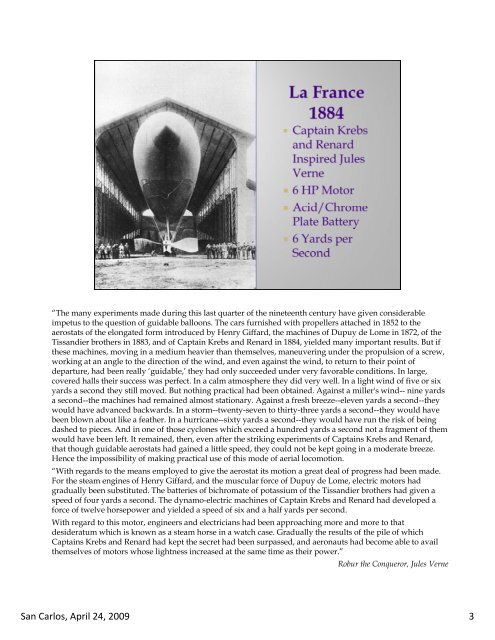Electric Motors and Controllers for Use in ... - CAFE Foundation
Electric Motors and Controllers for Use in ... - CAFE Foundation
Electric Motors and Controllers for Use in ... - CAFE Foundation
Create successful ePaper yourself
Turn your PDF publications into a flip-book with our unique Google optimized e-Paper software.
“The many experiments made dur<strong>in</strong>g this last quarter of the n<strong>in</strong>eteenth century have given considerable<br />
i impetus to the h question i of f guidable id bl bballoons. ll Th The cars furnished f i h d with i h propellers ll attached h d <strong>in</strong> i 1852 to the h<br />
aerostats of the elongated <strong>for</strong>m <strong>in</strong>troduced by Henry Giffard, the mach<strong>in</strong>es of Dupuy de Lome <strong>in</strong> 1872, of the<br />
Tiss<strong>and</strong>ier brothers <strong>in</strong> 1883, <strong>and</strong> of Capta<strong>in</strong> Krebs <strong>and</strong> Renard <strong>in</strong> 1884, yielded many important results. But if<br />
these mach<strong>in</strong>es, mov<strong>in</strong>g <strong>in</strong> a medium heavier than themselves, maneuver<strong>in</strong>g under the propulsion of a screw,<br />
work<strong>in</strong>g at an angle to the direction of the w<strong>in</strong>d, <strong>and</strong> even aga<strong>in</strong>st the w<strong>in</strong>d, to return to their po<strong>in</strong>t of<br />
departure, had been really ‘guidable,’ they had only succeeded under very favorable conditions. In large,<br />
covered halls their success was perfect. In a calm atmosphere they did very well. In a light w<strong>in</strong>d of five or six<br />
yards a second they still moved. But noth<strong>in</strong>g practical had been obta<strong>in</strong>ed. Aga<strong>in</strong>st a miller's w<strong>in</strong>d-- n<strong>in</strong>e yards<br />
a second--the mach<strong>in</strong>es had rema<strong>in</strong>ed almost stationary. Aga<strong>in</strong>st a fresh breeze--eleven yards a second--they<br />
would have advanced backwards. In a storm--twenty-seven to thirty-three yards a second--they would have<br />
been blown about like a feather. In a hurricane--sixty yards a second--they would have run the risk of be<strong>in</strong>g<br />
dashed to pieces. And <strong>in</strong> one of those cyclones which exceed a hundred yards a second not a fragment of them<br />
would have been left. It rema<strong>in</strong>ed, then, even after the strik<strong>in</strong>g experiments of Capta<strong>in</strong>s Krebs <strong>and</strong> Renard,<br />
that though guidable aerostats had ga<strong>in</strong>ed a little speed, they could not be kept go<strong>in</strong>g <strong>in</strong> a moderate breeze.<br />
Hence the impossibility of mak<strong>in</strong>g practical use of this mode of aerial locomotion.<br />
“With With regards to the means employed to give the aerostat its motion a great deal of progress had been made made.<br />
For the steam eng<strong>in</strong>es of Henry Giffard, <strong>and</strong> the muscular <strong>for</strong>ce of Dupuy de Lome, electric motors had<br />
gradually been substituted. The batteries of bichromate of potassium of the Tiss<strong>and</strong>ier brothers had given a<br />
speed of four yards a second. The dynamo-electric mach<strong>in</strong>es of Capta<strong>in</strong> Krebs <strong>and</strong> Renard had developed a<br />
<strong>for</strong>ce of twelve horsepower <strong>and</strong> yielded a speed of six <strong>and</strong> a half yards per second.<br />
With regard to this motor, eng<strong>in</strong>eers <strong>and</strong> electricians had been approach<strong>in</strong>g more <strong>and</strong> more to that<br />
desideratum which is known as a steam horse <strong>in</strong> a watch case. Gradually the results of the pile of which<br />
Capta<strong>in</strong>s Krebs <strong>and</strong> Renard had kept the secret had been surpassed, <strong>and</strong> aeronauts had become able to avail<br />
themselves h l of f motors whose h lih lightness i<strong>in</strong>creased d at the h same time i as their hi power.” ”<br />
Robur the Conqueror, Jules Verne<br />
San Carlos, April 24, 2009<br />
3

















